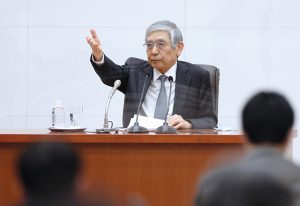Daniel Moss | Gearoid Reidy
Haruhiko Kuroda is summoning his inner Wim Duisenberg. The first president of the European Central Bank, Duisenberg resisted calls to adjust interest rates two decades ago with the retort “I hear, but I do not listen.â€
At the time, Duisenberg was under pressure to follow the Federal Reserve and reduce the cost of money. Kuroda, the Bank of Japan governor, finds new ways every month to restate his refusal to mimic the Fed, and just about every counterpart, by lifting rates. The case for the status quo isn’t getting easier. Inflation in Tokyo climbed more than anticipated this month to the most since 1989, and well above of the 2% inflation target Kuroda has long strived to achieve.
Much as Kuroda’s resoluteness has contributed to a dramatic weakening of the yen — it’s down about 22% this year — he seems able to bear the pain. He might even be on the right side of history. The dollar has retreated from a record high amid optimism that the Fed may be approaching the end of its jumbo hikes and be ready to adjust to a slightly less hawkish stance. Similar vibes have been sent recently by monetary authorities in the euro zone, Australia, Singapore, Canada and New Zealand.
Why would Kuroda want to repeat some inglorious episodes from BOJ history and begin withdrawing stimulus just as the global economy is weakening? His predecessors lifted off from near zero in 2000 and 2006, only to retreat in the world downdrafts that followed.
Earlier this year, popular opinion among market participants seemed to hold that the Bank of Japan “must†follow the trend of other major central banks in switching to a tightening cycle. But Japan diverging from the rest of the world in monetary policy has been the historical norm for the past three decades. The past months have simply been a reversion to that mean.
Kuroda will be hoping that by resisting calls to raise rates and staring down the markets, he’s timed things better than those others who have occupied his role before him. With just one more monetary policy meeting left this year, he may have weathered the storm of elevated inflation and the weak yen. Both of these problems look likely to be alleviated as the Fed tiptoes toward a less hawkish stance.
He’s consistently said it would take very large rate hikes for policy to meaningfully bolster the currency. The positive effect of such a move on Japan’s inflation, which is mostly imported, is less certain. The downsides of tightening are clear: the economy, still recovering from Covid, isn’t burning anywhere near hot enough to warrant proactively cooling demand.
On Friday, he also pushed back against what he called a prevailing market theory. “It’s one-sided to focus on the rate differential between Japan and the US to explain the yen’s recent moves,†Kuroda said, challenging reporters to try and chart the correlation. “It’s true that people say this a lot recently, but I don’t know if it’s correct from an economic theory point of view.†He might have a point — during the last Fed tightening cycle, the BOJ was delving for the first time into negative rates.
At its policy meeting, the BOJ kept its main rate negative and stuck with efforts to keep the yield on 10-year government bonds near zero. If Kuroda was to try to prepare the ground for a move toward minimum normalcy, a first step would be to tweak the guidance that rates may need to go lower. No movement there.
—Bloomberg
 The Gulf Time Newspaper One of the finest business newspapers in the UAE brought to you by our professional writers and editors.
The Gulf Time Newspaper One of the finest business newspapers in the UAE brought to you by our professional writers and editors.
